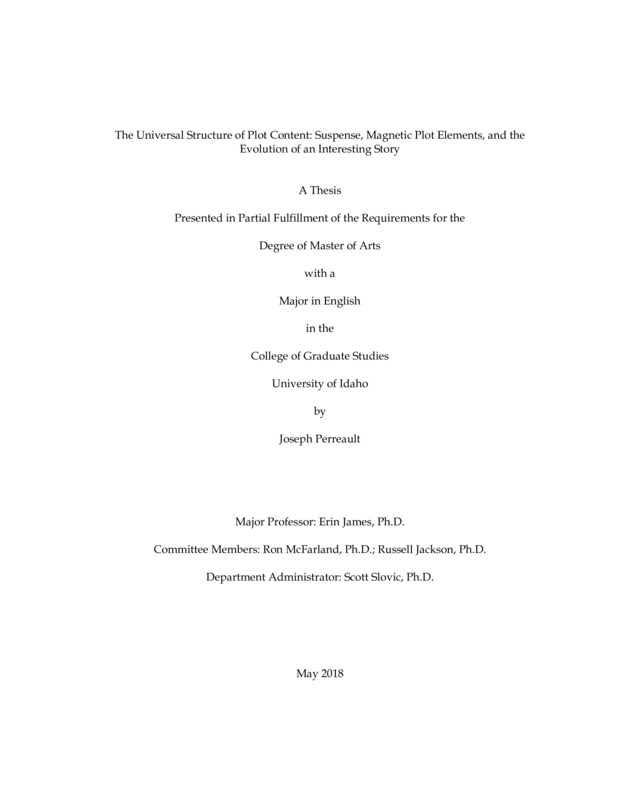The Universal Structure of Plot Content: Suspense, Magnetic Plot Elements, and the Evolution of an Interesting Story
Perreault, Joseph Raymond. (2018-05). The Universal Structure of Plot Content: Suspense, Magnetic Plot Elements, and the Evolution of an Interesting Story. Theses and Dissertations Collection, University of Idaho Library Digital Collections. https://www.lib.uidaho.edu/digital/etd/items/perreault_idaho_0089n_11380.html
- Title:
- The Universal Structure of Plot Content: Suspense, Magnetic Plot Elements, and the Evolution of an Interesting Story
- Author:
- Perreault, Joseph Raymond
- ORCID:
- 0000-0001-5776-0316
- Date:
- 2018-05
- Keywords:
- Content Evolution Narrative Plot Structure Supense
- Program:
- English
- Subject Category:
- English literature; Evolution & development; Cognitive psychology
- Abstract:
-
This thesis is a theoretical framework for the universal structure of plot content. In it, I propose a three-part structure with narrative suspense as the keystone of plot: first, suspense is cued by the introduction of a plot element [IPE]; second, the plot element is constrained [C] by subsequent narrative elements that restrict potential outcomes; and third, the plot element is resolved [R] by answering potential questions posed by the introduced plot element. Thus: [IPE] + [C] + [R] = a grammatical plot unit, which can represent either a part or whole of a fictional narrative. Multiple plots can overlap, connect, or both to make up larger narrative structures combinatorially. Additionally, I explore universal suspense cues, which I call “magnetic plot elements.” These sixteen categories of suspense cues have been derived from the study of thousands of stories of different genres, lengths, media, and cultures, and are shown herein to be highly connected to evolutionary concerns. Further, I explore three exemplar texts of one category of magnetic plot elements—dilemma. Examination of these dilemma narratives, “Defender of the Faith” by Philip Roth, “Delicate Edible Birds” by Lauren Groff, and “St. Lucy’s Home for Girls Raised by Wolves” by Karen Russell, demonstrates how this three-part structural heuristic can be used as an analytic tool for plot content. Its use provides precise, empirical methodology for criticism and comparison that presents avenues to deeper understanding of narrative content. Lastly, I propose potential uses for this structural heuristic across multiple scholarly and scientific disciplines, ranging from literary studies to cognitive poetics to cultural anthropology.
- Description:
- masters, M.A., English -- University of Idaho - College of Graduate Studies, 2018-05
- Major Professor:
- James, Erin
- Committee:
- McFarland, Ron; Jackson, Russell
- Defense Date:
- 2018-05
- Identifier:
- Perreault_idaho_0089N_11380
- Type:
- Text
- Format Original:
- Format:
- application/pdf
- Rights:
- In Copyright - Educational Use Permitted. For more information, please contact University of Idaho Library Special Collections and Archives Department at libspec@uidaho.edu.
- Standardized Rights:
- http://rightsstatements.org/vocab/InC-EDU/1.0/

